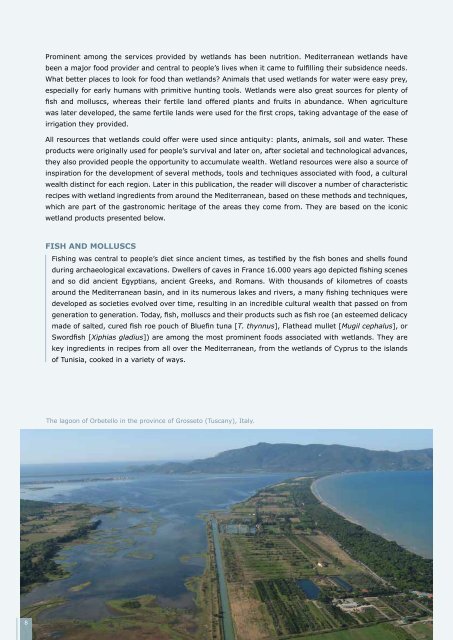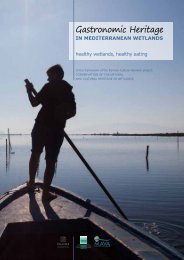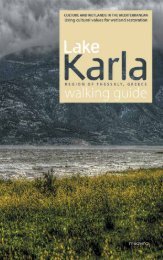Gastronomic Heritage in Mediterranean wetlands ebook
Recipe book featuring traditional Mediterranean dishes cooked with ingredients harvested around wetlands.
Recipe book featuring traditional Mediterranean dishes cooked with ingredients harvested around wetlands.
Create successful ePaper yourself
Turn your PDF publications into a flip-book with our unique Google optimized e-Paper software.
Prom<strong>in</strong>ent among the services provided by <strong>wetlands</strong> has been nutrition. <strong>Mediterranean</strong> <strong>wetlands</strong> have<br />
been a major food provider and central to people’s lives when it came to fulfill<strong>in</strong>g their subsidence needs.<br />
What better places to look for food than <strong>wetlands</strong>? Animals that used <strong>wetlands</strong> for water were easy prey,<br />
especially for early humans with primitive hunt<strong>in</strong>g tools. Wetlands were also great sources for plenty of<br />
fish and molluscs, whereas their fertile land offered plants and fruits <strong>in</strong> abundance. When agriculture<br />
was later developed, the same fertile lands were used for the first crops, tak<strong>in</strong>g advantage of the ease of<br />
irrigation they provided.<br />
All resources that <strong>wetlands</strong> could offer were used s<strong>in</strong>ce antiquity: plants, animals, soil and water. These<br />
products were orig<strong>in</strong>ally used for people’s survival and later on, after societal and technological advances,<br />
they also provided people the opportunity to accumulate wealth. Wetland resources were also a source of<br />
<strong>in</strong>spiration for the development of several methods, tools and techniques associated with food, a cultural<br />
wealth dist<strong>in</strong>ct for each region. Later <strong>in</strong> this publication, the reader will discover a number of characteristic<br />
recipes with wetland <strong>in</strong>gredients from around the <strong>Mediterranean</strong>, based on these methods and techniques,<br />
which are part of the gastronomic heritage of the areas they come from. They are based on the iconic<br />
wetland products presented below.<br />
Fish and molluscs<br />
Fish<strong>in</strong>g was central to people’s diet s<strong>in</strong>ce ancient times, as testified by the fish bones and shells found<br />
dur<strong>in</strong>g archaeological excavations. Dwellers of caves <strong>in</strong> France 16.000 years ago depicted fish<strong>in</strong>g scenes<br />
and so did ancient Egyptians, ancient Greeks, and Romans. With thousands of kilometres of coasts<br />
around the <strong>Mediterranean</strong> bas<strong>in</strong>, and <strong>in</strong> its numerous lakes and rivers, a many fish<strong>in</strong>g techniques were<br />
developed as societies evolved over time, result<strong>in</strong>g <strong>in</strong> an <strong>in</strong>credible cultural wealth that passed on from<br />
generation to generation. Today, fish, molluscs and their products such as fish roe (an esteemed delicacy<br />
made of salted, cured fish roe pouch of Bluef<strong>in</strong> tuna [T. thynnus], Flathead mullet [Mugil cephalus], or<br />
Swordfish [Xiphias gladius]) are among the most prom<strong>in</strong>ent foods associated with <strong>wetlands</strong>. They are<br />
key <strong>in</strong>gredients <strong>in</strong> recipes from all over the <strong>Mediterranean</strong>, from the <strong>wetlands</strong> of Cyprus to the islands<br />
of Tunisia, cooked <strong>in</strong> a variety of ways.<br />
The lagoon of Orbetello <strong>in</strong> the prov<strong>in</strong>ce of Grosseto (Tuscany), Italy.<br />
8






